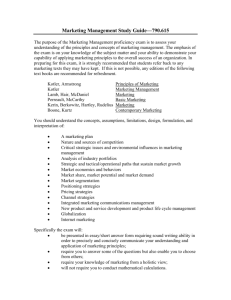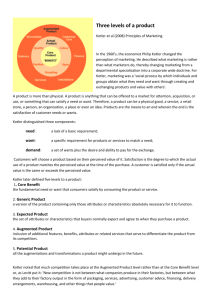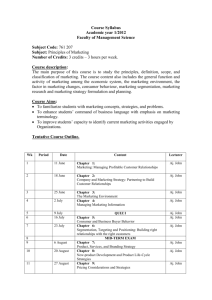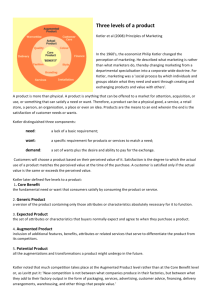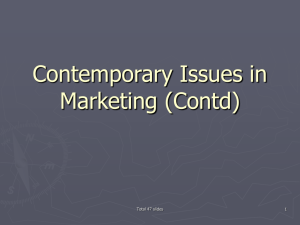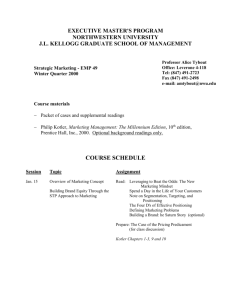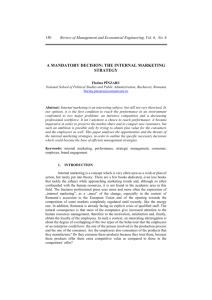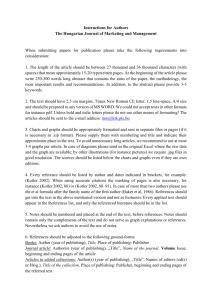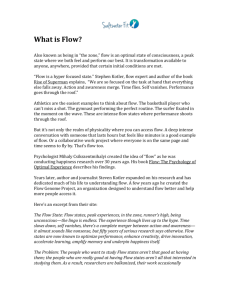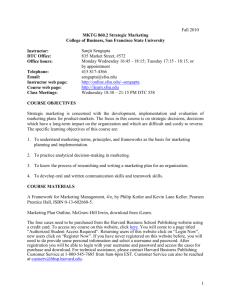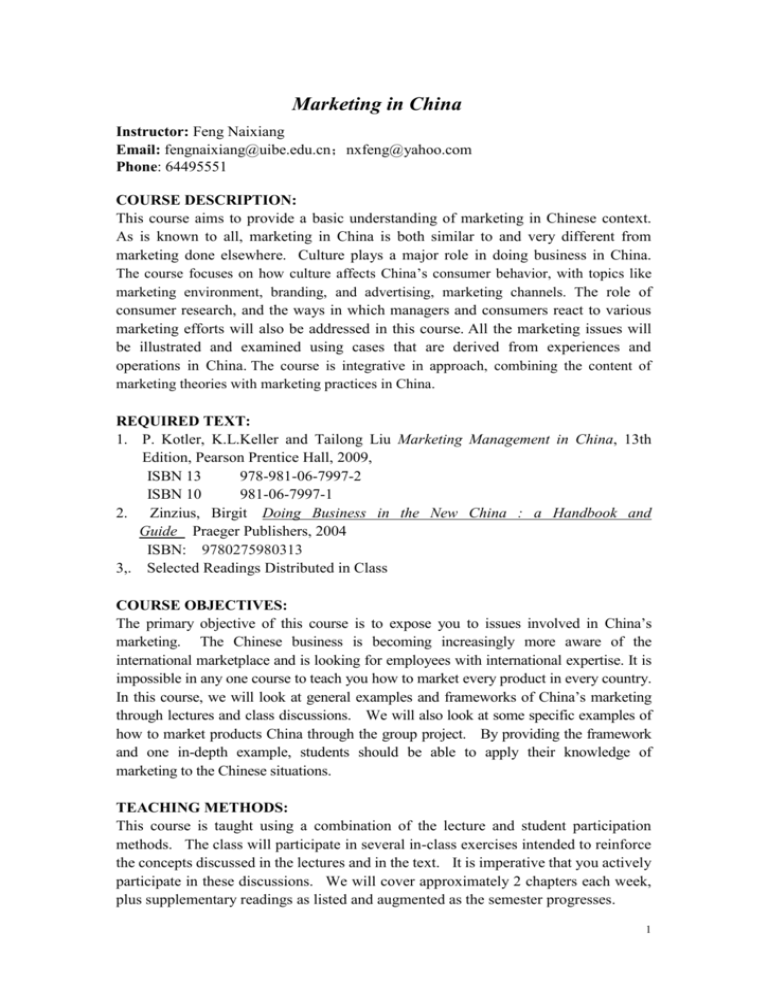
Marketing in China
Instructor: Feng Naixiang
Email: fengnaixiang@uibe.edu.cn;nxfeng@yahoo.com
Phone: 64495551
COURSE DESCRIPTION:
This course aims to provide a basic understanding of marketing in Chinese context.
As is known to all, marketing in China is both similar to and very different from
marketing done elsewhere. Culture plays a major role in doing business in China.
The course focuses on how culture affects China’s consumer behavior, with topics like
marketing environment, branding, and advertising, marketing channels. The role of
consumer research, and the ways in which managers and consumers react to various
marketing efforts will also be addressed in this course. All the marketing issues will
be illustrated and examined using cases that are derived from experiences and
operations in China. The course is integrative in approach, combining the content of
marketing theories with marketing practices in China.
REQUIRED TEXT:
1. P. Kotler, K.L.Keller and Tailong Liu Marketing Management in China, 13th
Edition, Pearson Prentice Hall, 2009,
ISBN 13
978-981-06-7997-2
ISBN 10
981-06-7997-1
2. Zinzius, Birgit Doing Business in the New China : a Handbook and
Guide Praeger Publishers, 2004
ISBN: 9780275980313
3,. Selected Readings Distributed in Class
COURSE OBJECTIVES:
The primary objective of this course is to expose you to issues involved in China’s
marketing. The Chinese business is becoming increasingly more aware of the
international marketplace and is looking for employees with international expertise. It is
impossible in any one course to teach you how to market every product in every country.
In this course, we will look at general examples and frameworks of China’s marketing
through lectures and class discussions. We will also look at some specific examples of
how to market products China through the group project. By providing the framework
and one in-depth example, students should be able to apply their knowledge of
marketing to the Chinese situations.
TEACHING METHODS:
This course is taught using a combination of the lecture and student participation
methods. The class will participate in several in-class exercises intended to reinforce
the concepts discussed in the lectures and in the text. It is imperative that you actively
participate in these discussions. We will cover approximately 2 chapters each week,
plus supplementary readings as listed and augmented as the semester progresses.
1
COURSE REQUIREMENTS:
·Marketing moments will be used in class to demonstrate examples of how marketing
can apply to real world situations. Marketing Moments – Five to ten minutes of each
class will be reserved for students to present to the class current marketing practices
relating to the chapter currently being studied. The presented practices are to be
supported by a write-up of the practice. Give the write-up to the professor prior to the
presentation. A printed article from a newspaper, journal, the web, annual report,
documented personal interview, etc. shall suffice as the core of the write-up, but
students are required to add their own commentary. These write-ups are to be
distributed at the very beginning of class for reading and review. A full citation of the
source of the write-up must be included with the write-up.
GRADING AND EVALUATION:
1. Assignments (pop quizzes and class participation) account for 10%. Excellent
classroom discussion on the Marketing Spotlights or on any other component of the
course, supported by adequate preparation, is an important component of the class
participation grade.
2. Group-based presentation/analysis will be 20%, which can be any topics in relevant with
marketing concepts, principles and issues.
3. Mid-term exam will be 20%, which will be inclusive of textbook material, supplementary
readings.
4. Final Essay: 50%, must be at least 2,000 words in length, which can be topics in
relevant to marketing in China. Journal articles and specialist books on the topic,
in Chinese or English, are both suitable sorts of reference. The essay must consult
at least 6 sources, and they must be listed.
TOTAL 100%
Grades will be calculated using the following scales:
Percentage
Grade
Percentage
Grade
93-100%
A
72-74%
C
90-92%
A-
69-71%
C-
87-89%
B+
66-68%
D+
83-86%
B
63-65%
D
80-82%
B-
60-62%
D-
75-79%
C+
0-59%
F
CLASS POLICIES:
2
1. Each student is responsible for obtaining all handouts, announcements, and
schedule changes.
2. Class starts on time. It is in your best interest to be punctual. Late arrivals to class
will not be admitted. Nor are you allowed to leave the class early.
3. Important class announcements may be communicated by e-mail. You are
responsible for checking your e-mail account regularly.
4. Class attendance is required. Students may miss no more than 2 classes for the
entire course. Only valid medical or family emergencies qualify as an absence, and
documentation of the same must be presented to the professor no later than the next
class meeting. Any missed class without authorized reason (such as a documented
health problem) beyond the allowed 2 sessions will lead to the exclusion of the
student from the class, and a failing grade.
ACADEMIC HONESTY STATEMENT:
Bottom Line: Don't Cheat. Do not plagiarize. Do not pass off others' work or
ideas as you own. It is also expected that students will not seek, receive, accept,
or give assistance on exams. Contribute fairly to group work. Always cite all
reference materials that you use (including materials from the www). When in
doubt, err on the safe side. Please refer to the following web link for policies on
academic honesty:
http://www.luc.edu/academics/catalog/undergrad/reg_academicintegrity.shtml
TENTATIVE SCHEDULE:
Class /
Week
Chapter Title or Topic
1
2
Chapter and
Reading
Assignments
Kick-off session: Introduction of the course;
An Overview of Marketing in China
Kotler:1-2
China’s Business Practices
Kotler:3-4
Zinzius:
pp
1-76; 121-127
Zinzius:
83-119
3
Kotler:5
Global and China’s Business Environment
McKinsey
consumers
Quarterly:
China’s
new
pp
Zinzius:
pragmatic 135-147
4
Analyzing Consumer Markets
Marketing in China: 1. The One-Child Generation
2. Transition of the Female Social Role
in China
5
Business Markets, Identifying Market Segments and Targets
pp
Kotler:6-7
3
Case: How Wal-Mart Does Purchasing in China
6
Mid-term exam (CH 1-7 INLCUSIVE)
Kotler:8,11
7
Creating Positioning and Dealing with Competition, Kotler:9-10
Designing and Managing Services
Zinzius:164-185
Case: Baidu’s Challenge for Google
Marketing in China: Wong Lo Kat
8
Branding in China
Cases: Huawei
Haier
Li Ning
9
Field trip*
Field trip report
Kotler:13&14
10
Marketing Channels, Retailing and Wholesaling
Kotler:16
Case: Gome
11
12
13
Advertising in China
Case: Bidding for Commercials in CCTV’s Prime Time
Global Marketing
Cases: Chery Automobiles
Microsoft
Final Paper Due
Kotler:19
Students’ presentation of the final paper
While this syllabus should provide you with an outline of the course, grading
criteria and a tentative schedule, please note that the instructor reserves the right to
modify this syllabus and schedule as deemed necessary.
*Field trip may take place at other week, depending on the time availability of the
Company we are to visit.
4

